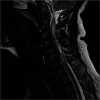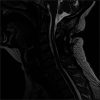Spinal intramedullary hemangioblastoma and schwannoma collision tumor: illustrative case
- PMID: 36034507
- PMCID: PMC9394162
- DOI: 10.3171/CASE2059
Spinal intramedullary hemangioblastoma and schwannoma collision tumor: illustrative case
Abstract
Background: Intramedullary spinal cord tumors represent a minority of intradural tumors. Among intramedullary spinal cord tumors, hemangioblastomas are uncommon, and schwannomas are extremely rare. Collision tumors are histologically distinct tumors that are intermingled and growing together.
Observations: In this report, the authors describe a patient with a cervical intramedullary collision tumor involving a hemangioblastoma and schwannoma. To the authors' knowledge, no prior spinal intramedullary collision tumor involving multiple neoplasms has been described. The patient's presentation and management are described.
Lessons: Clinicians should consider the possibility of collision tumors when evaluating intramedullary spinal cord tumors, especially when patient presentation and radiographic findings are atypical. When tumors with similar radiographic characteristics form collision tumors, distinction using preoperative imaging can be extremely challenging. In addition, surgical management of intramedullary collision tumors, like that for all intramedullary spinal cord tumors, should involve meticulous perioperative care and a methodical surgical technique. Maximal safe resection will depend upon histopathological diagnosis, anatomical location of the tumor, presence of distinct dissection planes, and stability of neuromonitoring. Finally, ongoing research on the genetics of intramedullary spinal cord tumors may identify underlying genetic links for intramedullary hemangioblastomas and schwannomas.
Keywords: GTR = gross-total resection; HBL = hemangioblastoma; HIF1α = hypoxia-inducible factor 1α; IMS = intramedullary schwannoma; IMSCT = intramedullary spinal cord tumor; MRI = magnetic resonance imaging; NF2 = neurofibromin 2; STIR = short tau inversion recovery; T1WI = T1-weighted imaging; T2WI = T2-weighted imaging; VHL = von Hippel-Lindau; collision tumor; hemangioblastoma; intramedullary spinal cord tumor; schwannoma; spine.
© 2021 The authors.
Conflict of interest statement
Disclosures Dr. Kalani does general consulting for Medtronic, Nuvasive, and CarboFix Orthopedics.
Figures





Similar articles
-
Differentiation of localization of spinal hemangioblastomas based on imaging and pathological findings.Eur Spine J. 2011 Aug;20(8):1377-84. doi: 10.1007/s00586-011-1814-6. Epub 2011 Apr 29. Eur Spine J. 2011. PMID: 21528401 Free PMC article.
-
Spinal cord hemangioblastomas: significance of intraoperative neurophysiological monitoring for resection and long-term outcome.J Neurosurg Spine. 2017 Apr;26(4):483-493. doi: 10.3171/2016.8.SPINE16595. Epub 2016 Dec 16. J Neurosurg Spine. 2017. PMID: 27982764
-
Hemorrhagic intramedullary hemangioblastoma of the cervical spinal cord presenting with acute-onset quadriparesis: case report and review of the literature.J Spinal Cord Med. 2014 Nov;37(6):791-4. doi: 10.1179/2045772314Y.0000000210. Epub 2014 Jul 16. J Spinal Cord Med. 2014. PMID: 25029412 Free PMC article. Review.
-
Cervical intradural intramedullary collision tumor of schwannoma and hemangioblastoma origin.Surg Neurol Int. 2021 Apr 14;12:155. doi: 10.25259/SNI_92_2021. eCollection 2021. Surg Neurol Int. 2021. PMID: 33948325 Free PMC article.
-
Primary Intradural Extramedullary Sporadic Spinal Hemangioblastomas: Case Report and Systematic Review.World Neurosurg. 2021 Aug;152:84-94. doi: 10.1016/j.wneu.2021.05.105. Epub 2021 Jun 1. World Neurosurg. 2021. PMID: 34087464
Cited by
-
Imaging of intramedullary tumours of the spinal cord.Pol J Radiol. 2024 Nov 15;89:e531-e540. doi: 10.5114/pjr/192424. eCollection 2024. Pol J Radiol. 2024. PMID: 39777329 Free PMC article. Review.
-
Intramedullary Schwannoma in the Cervical Region: A Case Report.Cureus. 2024 Nov 27;16(11):e74632. doi: 10.7759/cureus.74632. eCollection 2024 Nov. Cureus. 2024. PMID: 39735117 Free PMC article.
References
-
- Kandemirli SG, Reddy A, Hitchon P, et al. Intramedullary tumours and tumour mimics. Clin Radiol. 2020;75(11):876.e17–876.e32. - PubMed
-
- Tuleasca C, Knafo S, David P, et al. A rare condition: spontaneous subarachnoid hemorrhage due to spinal hemangioblastoma: report of 2 cases and review of the literature. Neurochirurgie. 2020;66(5):359–364. - PubMed
-
- Hussain I, Parker WE, Barzilai O, et al. Surgical management of intramedullary spinal cord tumors. Neurosurg Clin N Am. 2020;31(2):237–249. - PubMed
-
- Landi A, Grasso G, Gregori F, et al. Isolated pediatric intramedullary schwannoma: case report and review of literature. World Neurosurg. 2018;115:417–420. - PubMed
Publication types
LinkOut - more resources
Full Text Sources
Research Materials
Miscellaneous

